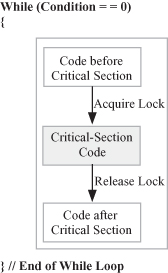4.3 SYNCHRONIZATION AND MUTUAL EXCLUSION
Each process or thread operating on a shared variable has a segment of code called critical section, where the process operates on the shared variable by changing its value. When a process is executing its critical section, no other process on any processor is allowed to execute its critical section. Figure 4.6 shows a segment of code containing a critical section. When a process reaches the critical section code, it is allowed to enter it and to execute that code section only if it can acquire a lock. As soon as the process is done with the critical section, it releases the lock and proceeds to execute the code after the critical section. If two or more processes reach the critical section, only one process is allowed to acquire the lock. All other processes wait at the start of the critical section.
Figure 4.6 Segment of code showing a critical section within a normal code.

Dijkstra [36] and Knuth [132] showed that it is possible to provide synchronization and mutual exclusion using atomic read and write operations [37]. Atomic operations ensure that the memory read, modify, then write operation to a certain location is done without interference from other processors. This basic capability is provided by hardware and enables the construction of more elaborate software algorithms. Examples of low-level hardware atomic operations include ...
Get Algorithms and Parallel Computing now with the O’Reilly learning platform.
O’Reilly members experience books, live events, courses curated by job role, and more from O’Reilly and nearly 200 top publishers.

